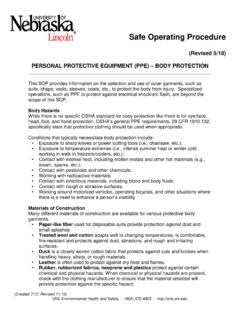Transcription of Harness Inspection Guidelines
1 Harness Inspection Guidelines Webbing Grasp the webbing with your hands and bend the webbing, checking both sides. This creates surface tension making damaged fibers or cuts easier to see. Webbing damage may not show up through a sight (visual) Inspection only - manual (touch) the Harness is equally important. Visual and Touch Inspection JPass Fail Criteria Cuts, nicks or tears Broken fibers/cracks Overall deterioration Modifications by user Fraying/Abrasions J Discoloration of material Dependant on cause of discoloration Hard or shiny spots Indicates heat damage Webbing thickness uneven Indicates possible fall JMildew Clean Harness Missing Straps Undue Stretching Indicates possible fall Burnt.
2 Charred or melted fibers Indicates heat damage J Material marked w/permanent marker Check w/manufacturer Excessive hardness or brittleness Indicates heat or uv damage Stitching Visual and Touch Inspection Pulled stitches Stitching that is missing Hard or shiny spots Indicates heat damage Cut stitches J Discoloration of stitching Dependant on cause of discoloration Hardware Visual and Touch Inspection Distortion (twists, bends) Rough or sharp edges Rust or corrosion Cracks or breaks Broken/distorted grommets Modification by users (ie additional holes). Tongue buckle should overlap the buckle frame and move freely back and forth in their socket Roller of tongue buckle should turn freely on frame Bars must be straight All springs must be in working condition Product Inspection Guide 1.
3 Harness Inspection - Guidelines Tagging System Every Harness must have a legible tag identifying the Harness , model, date of manufacture, name of manufacturer, limitations and warnings. Check tag for date of manufacture and remove from service if past adopted service life policy If tagging system is missing or not legible remove Harness from service. Cleaning and Storage Wipe off all surface dirt with a sponge dampened in plain water. Squeeze the sponge dry. Dip the sponge in a mild solution of water and mild detergent. Work up a thick lather, with a vigorous back and forth motion. Then wipe dry with a clean cloth. Hang freely to dry, but away from excessive heat, steam or long periods of sunlight.
4 Storage areas should be clean, dry and free of exposure to fumes, heat, direct ultra violet light, sunlight and corrosive elements. Note: Do not store harnesses next to batteries, chemical attack can occur if battery leaks. Product Inspection Guide 2. Inspection Checklist - Fall Protection Equipment Description: Model#: Serial#: Date of Manufacture: Inspector: Date Inspected: Inspector Signature: FAIL: 0 Initial- - - - J' PASS: 0 Initial ---- REMOVE FROM SERVICE RETURN TO SERVICE. ITEM# DESCRIPTION FAIL PASS COMMENTS. J'. Product Inspection Guide 3. Inspection CHECKLIST - Harness . ITEM DESCRIPTION. f . X ./ Dee Ring 6. 3. 2. x ./Dee Pad 3. X ./ Nylon Webbing 4.
5 It ./ Spring Loaded Friction Buckles 5. x ./ Elastic Keepe~ (2). 6. It ./ Nylon Webbing 7. Jt ./ Spring Loaded Friction Buckles 8. X ./ Elastic K f>GB (2). 9. Jt ./ Nylon Webbing 10. Jt ./ Stnching 11 It ./ Stitching 12. )( ./ I ongue B"ckl~. 13. X ./ Elastic Keeper (1). 14. X ./ Nylon Webbing 15. x ./ Stitching f 6. It ./ Stitching 17. X ./ Tongue Buckle 1B. X ./ Elastic Keeper ( 1). 19. x ./ Stitching 20. X ./ Nylon Webbing 21 X ./ Stitching 22, X ./ Stitching 23. X ./ Nylon Webbing 24. It ./ Grommets 25. x ./ Stitching 26. X ./ Ny1on Webbing 27. x ./ Sti tching 28 X ./ Stitching 29. X ./ Nylon Webbing 30 X ./ Grommets 31. X ./ Sub-Pelvic Strap 32.
6 X ./ Back Strap 33. X ./ Stitching - Back Strap 34. x ./ Stnching - Back Strap 35. X ./ Chest Strap Pad 36. X ./ Nylon Webbing 37. X ./ Sti tching 38. X ./ Mating Link 39. X ./ Chest Strap Pad SERfAL H_ _ _ _ _ DATE OF MANUF_ _ _ _ __. 40. X ./ Nylon Wel>bing 41. x ./ Stitching JNSPECTOR'--- - DATE OF INSPECTION_ _ _ _. 42. X ./ 3 Bar Mating Buckle 43 X ./ E lastic Keeper / 1). 44. x ./ Tagging/Label System INSPEC IUR SIGNATURE_ _ _ __ _ __ _ _ _ _ _ __. X FALL: U fnitial .I _ __. CRITERIA X FAIL = ---- REMOVE FROM SERVICE TO ./=PASS. Product Inspection Guide 4. \. [[]. I. D-ring (DR). Buckles (8U). /. stitch patterns (SP). of threads (TH}. Examples of Some Typical Thread (TH) and sittchPattems (SP) in Webbing 0l'f}.]
7 Product Inspection Guide 5. Adjuster, webbing (Also a buckle). Buckle, tongue Grocrme! Grommeis in webbing Exarrple oi Some Typical Connoctor (Hardware) Components and Elements Product Inspection Gulde 6. Lanyard Inspection Shock Absorbing Lanyard (Manyard Style). Inspection - Guidelines Webbing Grasp the webbing with your hands and bend the webbing, checking both sides. This creates surface tension making damaged fibers or cuts easier to see. Webbing damage may not show up through a sight (visual) Inspection only - manual (touch) the lanyard is equally important. Pay attention to the wrinkled portion of the lanyard. Visual and Touch Inspection ./Pass Fail Criteria cuts, nicks or tears Broken fibers/cracks Overall deterioration Modifications by user Fraying/Abrasions.
8 / Discoloration of material Dependant on cause of discoloration Hard or shiny spots Indicates heat damage Change in core size Indicates possible fall ./Mildew Clean lanyard Missing or popped flag Indicates possible fall Undue Stretching Indicates possible fall Burnt, charred or melted fibers Indicates heat damage ./Material marked w/permanent marker Check w/manufacturer Excessive hardness or brittleness Indicates heat or uv damage Knots in lanyard Stitching Visual and Touch Inspection Pulled stitches Stitching that is missing Hard or shiny spots Indicates heat damage Cut stitches ./Discoloration of stitching Dependant on cause of discoloration Product Inspection Guide 7.















